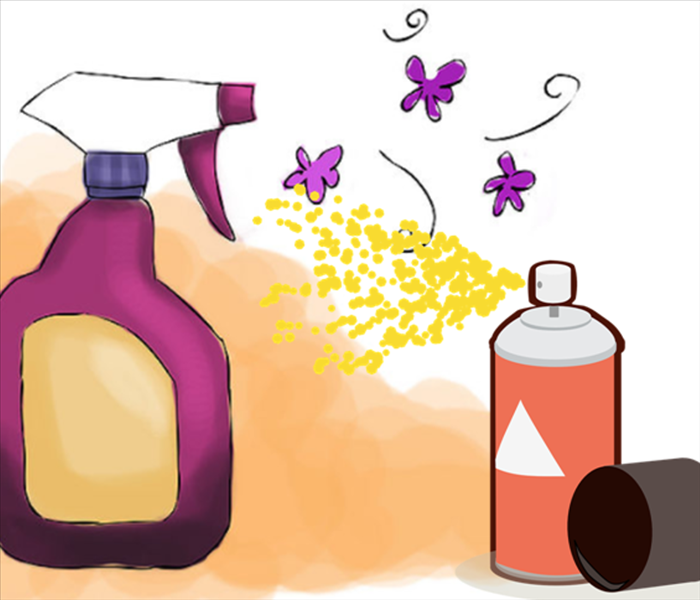Odor Neutralization Agents And Techniques
12/6/2017 (Permalink)
As we have discussed previously there are many kinds and types of malodors. As such, there are many types of neutralizing agents and techniques to use to counteract malodors – each of which affect malodors in different ways.
Here is a list of various deodorants and deodorizing actions;
- Masking agents
- Pairing agents
- Filtration agents
- Disinfectants and sanitizers
- Enzymes
- Air purification
- Oxidation
Masking Agents
Masking agents are not a primary deodorizer for a real odor situation because they do not eliminate odors. Instead, masking agents cover malodors with a more pleasant odor. Usually masking agents are packed in a time-release form, such as beads, wicks, gels, blocks, or solid cakes, so they generate pleasant-smelling vapors for long periods of time. This slow release of deodorant vapors makes masking agents a good weapon against imaginary odors.
Pairing Agents
Pairing agents are chemicals that combine with (or pair with) odor particles. Most deodorants used for fire restoration contain both masking agents and pairing agents. Two different types of pairing agents affect odor particles in different ways:
- Humectant — A highly absorptive material that combines with airborne odor particles and causes them to precipitate onto surfaces where they can be cleaned up. Wet fogging uses this process.
- Counteractant — A neutralizer that combines chemically with odor particles and changes the chemical properties of the odor molecule or destroys odor-causing bacteria. Thermal fogging works in this manner.
Filtration Agents
Filtration agents collect odors in one of two ways - Absorption or Adsorption.
- Absorption agents primarily absorb moisture and odors into the deodorizing agent. This absorbing action occurs when baking soda is placed in a refrigerator to pick up odors. One type of absorption agent is a powder composed of highly absorptive compounds, inert fillers, and perfume. These powders are not very effective because they mostly absorb humidity and oils and do not attack the real odor problem. They are sprinkled on carpets, but can build up in carpets and damage fibers.
- Adsorption agents work by capturing odor gases from the air and holding them on the surface of the agent. These processes are used to filter odor gases from air passing by or through the filtration agent. Activated charcoal is a type of adsorption agent often used in air filtration systems.
Disinfectants and Sanitizers
Growing bacteria and fungi create odors by producing gases. Disinfecting or killing these odor- causing organisms is a form of deodorization. Some chemicals are classified as disinfectants or sanitizers. In the restoration industry these terms have specific technical meanings:
- Disinfectants are stronger than sanitizers.
- The suffix – "stat" means “to control or limit.” A fungistat controls the growth of fungi such as molds.
- The suffix – "cide" means “to kill.” A fungicide stops the growth of fungi, killing the organism.
Some common disinfectants are pine oil, alcohol, bleach, phenolic disinfectants, and quaternary ammonia solutions. These agents are usually combined with a pleasant fragrance. The disinfectants kill the odor causing bacteria and fungi and the fragrance handles the psychological odors.
Enzyme Digesters
Enzyme digesters work effectively on organic or protein materials. Unlike chemical deodorizers, enzymes break down organic odor molecules into substances without odor. The enzyme deodorizer breaks down odor molecules into carbon dioxide (CO2), water (H2O), and water soluble by-products, and these substances dissipate rapidly into the air. The odor is “eradicated.” Enzymes also break down insoluble protein molecules into simple, soluble substances, which can be absorbed by the bacteria and digested.
Air Purification
Purifying the air is a means of removing odors from indoor air.
- Electronic filters use an electrically charged grid to kill airborne microorganisms as they pass through the filter.
- Air scrubbers pull air through charcoal filters, capturing odors onto a filter and recirculating the filtered air back into the indoor environment.
- Ventilation fans exchange indoor and outdoor air, exhausting odors outside and drawing fresh air indoors from outside.
Oxidation
Oxidation occurs when a substance combines with oxygen. Ozone generators produce ozone gas (O3), which permanently destroys odor through an oxidation process. Ozone gas is an unstable oxygen molecule composed of three oxygen atoms. When this unstable molecule comes in contact with an odor particle, the extra oxygen atom combines with the odor particle and oxidizes it. There are, unfortunately, safety concerns to consider prior to performing any oxidation procedure. Like most “chemical” products, ozone can be hazardous, but if used properly this method of deodorization is as safe as other available methods. Safety precautions must be taken when deodorizing with ozone. Use activated oxygen only in unoccupied areas. Ozone is toxic when high concentrations are inhaled, so remove all people and pets from the areas to be ozoned. Ozone Warning signs should be placed at all entries prior to performing activated oxygen procedures. Only certified technicians should enter the oxidized area until it has been determined to be safe by the technician.
Next I will share with you the various types of equipment our technicians have at their disposal.





 24/7 Emergency Service
24/7 Emergency Service
